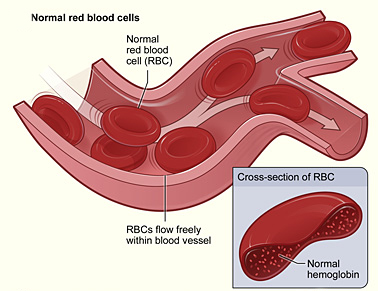Haemolytic Anaemia
Haemolytic anaemia is a type of anaemia caused by the premature breakdown of red blood cells (RBCs), a process known as haemolysis. This can occur within the blood vessels (intravascular haemolysis) or elsewhere in the body, most commonly in the spleen (extravascular haemolysis). It accounts for about 5% of all anaemias and can have a wide range of consequences, from mild symptoms to life-threatening effects. The condition is classified as either intrinsic or extrinsic, depending on the underlying cause. Treatment varies based on the type and cause of haemolytic anaemia.

Signs and Symptoms
The symptoms of haemolytic anaemia are similar to other forms of anaemia and include fatigue, pallor, shortness of breath, and tachycardia. In children, this may also manifest as a failure to thrive. Symptoms specifically related to haemolysis include chills, jaundice, dark urine, and an enlarged spleen. Certain historical factors such as drug use, autoimmune disorders, blood transfusion reactions, or the presence of a prosthetic heart valve can provide clues to the cause of haemolysis. Chronic haemolysis can lead to complications like gallstones and pulmonary hypertension, which can further cause syncope, chest pain, and progressive breathlessness, eventually leading to right ventricular heart failure.
Causes
Haemolytic anaemia can be due to intrinsic factors related to RBCs themselves or extrinsic factors affecting RBCs from the outside.
Intrinsic Causes
Hereditary haemolytic anaemia can result from:
- Defects in red blood cell membrane production, such as hereditary spherocytosis and hereditary elliptocytosis.
- Defects in haemoglobin production, including thalassaemia, sickle-cell disease, and congenital dyserythropoietic anaemia.
- Defective red cell metabolism, as seen in glucose-6-phosphate dehydrogenase deficiency and pyruvate kinase deficiency.
- Rarely, Wilson's disease due to excessive inorganic copper in blood circulation.
Extrinsic Causes
Acquired haemolytic anaemia can be due to:
- Immune-mediated causes like autoimmune haemolytic anaemia, which can be associated with diseases such as systemic lupus erythematosus and rheumatoid arthritis.
- Spur cell haemolytic anaemia.
- Hypersplenism due to conditions like portal hypertension.
- Burns, infections like malaria, and other toxins like lead, arsine, or stibine poisoning.
- Paroxysmal nocturnal haemoglobinuria (PNH).
- Footstrike haemolysis in runners.
- Prosthetic heart valves, which can cause low-grade or severe haemolytic anaemia.
Mechanism
Haemolysis in haemolytic anaemia can occur via intravascular or extravascular pathways.
Intravascular Haemolysis
Intravascular haemolysis happens within blood vessels, releasing RBC contents into the circulation, leading to haemoglobinaemia and hyperbilirubinaemia. This can occur due to autoantibodies or parasites like Babesia.
Extravascular Haemolysis
Extravascular haemolysis occurs in the liver, spleen, bone marrow, and lymph nodes, where macrophages destroy defective RBCs or those with antibodies attached, releasing unconjugated bilirubin into the plasma. Extensive extravascular haemolysis can result in haemosiderosis due to haemosiderin deposition in organs.

Diagnosis
Diagnosis is based on symptoms, anaemia, increased immature red cells (reticulocytes), and decreased haptoglobin levels. Examination of a peripheral blood smear can show RBC fragments (schistocytes), spherocytes, and bite cells. Laboratory tests for bilirubin, lactate dehydrogenase, and free haemoglobin binding protein haptoglobin, along with the direct Coombs test (DAT), are used to evaluate haemolytic anaemia.
Treatment
Treatment depends on the underlying cause:
- Symptomatic treatment includes blood transfusion, although a positive Coombs test is a relative contraindication.
- Steroid therapy is used for severe immune-related haemolytic anaemia.
- For steroid-resistant cases, rituximab or immunosuppressants like azathioprine or cyclophosphamide may be considered.
- Acute severe cases may be managed with methylprednisolone and intravenous immunoglobulin.
- Splenectomy can be helpful in cases of predominant extravascular haemolysis or hereditary spherocytosis.
Mitapivat was approved for medical use in the United States in February 2022.
Self-assessment MCQs (single best answer)
What is haemolytic anaemia?
Where does extravascular haemolysis primarily occur?
Which of the following is NOT a symptom of haemolytic anaemia?
Which of the following is a hereditary cause of haemolytic anaemia?
What does the direct Coombs test (DAT) detect?
Which treatment is used for severe immune-related haemolytic anaemia?
What can be a complication of chronic haemolysis?
Which laboratory finding is indicative of haemolytic anaemia?
What is the primary cause of intravascular haemolysis?
Which medication was approved for the treatment of haemolytic anaemia in the United States in February 2022?
Dentaljuce
Dentaljuce provides Enhanced Continuing Professional Development (CPD) with GDC-approved Certificates for dental professionals worldwide.
Founded in 2009 by the award-winning Masters team from the School of Dentistry at the University of Birmingham, Dentaljuce has established itself as the leading platform for online CPD.
With over 100 high-quality online courses available for a single annual membership fee, Dentaljuce offers comprehensive e-learning designed for busy dental professionals.
The courses cover a complete range of topics, from clinical skills to patient communication, and are suitable for dentists, nurses, hygienists, therapists, students, and practice managers.
Dentaljuce features Dr. Aiden, a dentally trained AI-powered personal tutor available 24/7 to assist with queries and provide guidance through complex topics, enhancing the learning experience.
Check out our range of courses, or sign up now!


